Trích từ: Trường Bộ Kinh – Chương 02 – Kinh Sa-Môn Quả – Tứ Thiền – The Four Jhānas Attainments – Song ngữ
English: Maurice Walshe.
Việt ngữ: Hòa thượng Thích Minh Châu – Phật Lịch 2535 – 1991.
Compile: Middle Way Group.
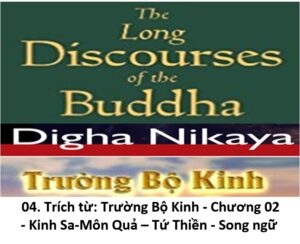
Note: Ghi Chú:
We are a nonprofit website, solely with the spirit of helping others. Please review the materials and choose the practices that are right for you. We, together with the contributing authors, waive the responsibility for the materials on this site. Hope for sympathy and joy.
Chúng tôi với tinh thần giúp người không vụ lợi. Xin quý vị xem xét các tài liệu và chọn lựa cách thực hành thích hợp cho mình. Chúng tôi, cùng các tác giả đóng góp, xin được miễn trách nhiệm về những tài liệu trên trang web này. Kính mong sự thông cảm và hoan hỷ.
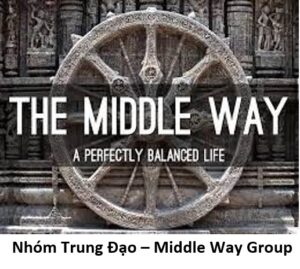
04. Trích từ: Trường Bộ Kinh – Chương 02 – Kinh Sa-Môn Quả – Tứ Thiền – The Four Jhānas Attainments – Song ngữ

- ‘Just as a man might be bound in prison, and after a time he might be freed from his bonds without any loss, with no deduction from his possessions. He might think: “Before this I was in prison…”, and he would rejoice and be glad about that.
Này Ðại vương, như một người bị nhốt trong ngục. Người ấy sau một thời gian, được khỏi tù tội, an lạc kiện toàn, tài sản không bị giảm tổn. Người ấy nghĩ: “Ta trước kia bị nhốt trong ngục, nay ta được khỏi tù tội, an lạc kiện toàn, tài sản không bị giảm tổn”. Người ấy nhờ vậy được sung sướng hoan hỷ.
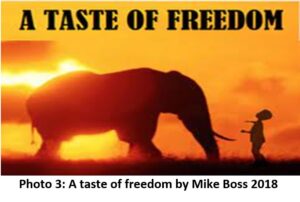
- ‘Just as a man might be a slave, not his own master, dependent on another, unable to go where he liked, and after some time he might be freed from slavery, able to go where he liked, might think: “Before this I was a slave…” [73] And he would rejoice and be glad about that.
Này Ðại vương, như một người nô lệ, không được tự chủ, lệ thuộc người khác, không được tự do đi lại. Người ấy, sau một thời gian, thoát khỏi cảnh nô lệ, được tự chủ, không lệ thuộc người khác, một người được giải thoát, được tự do đi lại. Người ấy nghĩ: “Ta trước kia bị cảnh nô lệ, không được tự chủ, lệ thuộc người khác, không được tự do đi lại. Nay ta thoát cảnh nô lệ, được tự chủ, không lệ thuộc người khác, một người được giải thoát, được tự do đi lại”. Người ấy nhờ vậy được sung sướng hoan hỷ.
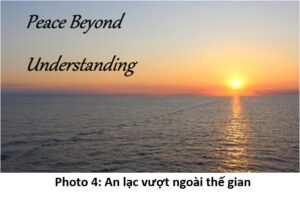
- ‘Just as a man, laden with goods and wealth, might go on a long journey through the desert where food was scarce and danger abounded, and after a time he would get through the desert and arrive safe and sound at the edge of a village, might think: “Before this I was in danger, now I am safe at the edge of a village”, and he would rejoice and be glad about that.
Này Ðại vương, như một người giàu có, nhiều tài sản, đang đi qua bãi sa mạc, thiếu lương thực, đầy những nguy hiểm. Người ấy, sau một thời gian đã đi khỏi sa mạc, đến đầu làng vô sự, yên ổn, không có nguy hiểm. Người ấy nghĩ: “Ta trước kia giàu có, nhiều tài sản, đi qua bãi sa mạc thiếu lương thực, đầy những nguy hiểm. Nay ta đã đi qua khỏi bãi sa mạc ấy, đến đầu làng vô sự, yên ổn, không có nguy hiểm”. Người ấy nhờ vậy được sung sướng hoan hỷ.
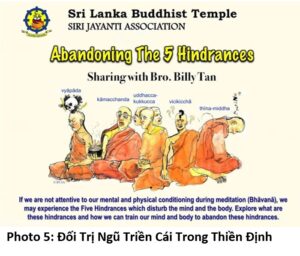
Đối Trị Ngũ Triền Cái Trong Thiền Định
- ‘As long, Sire, as a monk does not perceive the disappearance of the five hindrances in himself, he feels as if in debt, in sickness, in bonds, in slavery, on a desert journey. But when he perceives the disappearance of the five hindrances in himself, it is as if he were freed from debt, from sickness, from bonds, from slavery, from the perils of the desert.
Như vậy, này Ðại vương, Tỷ-kheo tự mình quán năm triền cái chưa xả ly, như món nợ, như bệnh hoạn, như ngục tù, như cảnh nô lệ, như con đường sa mạc. Này Ðại vương, cũng như không mắc nợ, như không bệnh tật, như được khỏi tù tội, như được tự do, như đất lành yên ổn, này Ðại vương, Tỷ-kheo quán năm triền cái khi diệt trừ chúng.
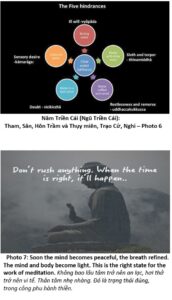
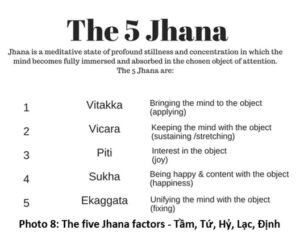
- ‘And when he knows that these five hindrances have left him, gladness arises in him, from gladness comes delight, from the delight in his mind his body is tranquillised, with a tranquil body he feels joy, and with joy his mind is concentrated. Being thus detached from sense-desires, detached from unwholesome states, he enters and remains in the first jhāna, which is with thinking and pondering, born of detachment, filled with delight and joy. And with this delight and joy born of detachment, he so suffuses, drenches, fills and irradiates his body that there is no spot in his entire body that is untouched by this delight and joy born of detachment.
Khi quán tự thân đã xả ly năm triền cái ấy, hân hoan sanh; do hân hoan nên hỷ sanh; do tâm hoan hỷ, thân được khinh an; do thân khinh an, lạc thọ sanh; do lạc thọ, tâm được định tĩnh. Tỷ-kheo ly dục, ly ác pháp, chứng và trú thiền thứ nhất, một trạng thái hỷ lạc do ly dục sanh, với tầm, với tứ. Tỷ-kheo thấm nhuần, tẩm ướt, làm cho sung mãn, tràn đầy thân mình với hỷ lạc do ly dục sanh, không một chỗ nào trên toàn thân không được hỷ lạc do ly dục sanh ấy thấm nhuần.
- ‘Just as a skilled bathman or his assistant, kneading the soap-powder which he has sprinkled with water, forms from it, in a metal dish, a soft lump, so that the ball of soap-powder becomes one oleaginous mass, bound with oil so that nothing escapes — so this monk suffuses, drenches, fills and irradiates his body so that no spot remains untouched. This, Sire, is a fruit of the homeless life, visible here and now, that is more excellent and perfect than the former ones.
Này Ðại vương, như một người hầu tắm lão luyện hay đệ tử người hầu tắm. Sau khi rắc bột tắm trong thau bằng đồng, liền nhồi bột ấy với nước, cục bột tắm ấy được thấm nhuần nước ướt, nhào trộn với nước ướt, thấm ướt cả trong lẫn ngoài với nước, nhưng không chảy thành giọt. Cũng vậy, này Ðại vương, Tỷ-kheo thấm nhuần, tẩm ướt, làm cho sung mãn, tràn đầy thân hình với hỷ lạc do ly dục sanh, không một chỗ nào trên toàn thân không được hỷ lạc do ly dục sanh ấy thấm nhuần.
Này Ðại vương, đó là quả thiết thực hiện tại của hạnh Sa-môn, còn vi diệu thù thắng hơn những quả thiết thực hiện tại của hạnh Sa-môn trước.
- ‘Again, a monk, with the subsiding of thinking and pondering, by gaining inner tranquillity and oneness of mind, enters and remains in the second jhāna, which is without thinking and pondering, born of concentration, filled with delight and joy. And with this delight and joy born of concentration he so suffuses his body that no spot remains untouched.
Lại nữa, này Ðại vương, Tỷ-kheo ấy diệt tầm và tứ, chứng và trú thiền thứ hai, một trạng thái hỷ lạc do định sanh, không tầm không tứ, nội tĩnh nhất tâm Tỷ-kheo ấy thấm nhuần, tẩm ướt làm cho sung mãn, tràn đầy thân mình với hỷ lạc do định sanh, không một chỗ nào trên toàn thân không được hỷ lạc do định sanh ấy thấm nhuần.
- ‘Just as a lake fed by a spring, with no inflow from east, west, north or south, where the rain-god sends moderate showers from time to time, the water welling up from below, mingling with cool water, would suffuse, fill and irradiate that cool water, so that no part of the pool was untouched by it — so, with this delight and joy born of concentration he so suffuses his body that no spot remains untouched. [75] This, Sire, is a fruit more excellent and perfect than the former ones.
Này Ðại vương, ví như một hồ nước, nước tự trong dâng lên, phương Ðông không có lỗ nước chảy ra, phương Tây không có lỗ nước chảy ra, phương Bắc không có lỗ nước chảy ra, phương Nam không có lỗ nước chảy ra, và thỉnh thoảng trời lại mưa lớn. Suối nước mát từ hồ nước ấy phun ra thấm nhuần, tẩm ướt, làm cho sung mãn tràn đầy hồ nước ấy, với nước mát lạnh, không một chỗ nào của hồ nước ấy không được nước mát lạnh thấm nhuần. Cũng vậy, này Ðại vương, Tỷ-kheo thấm nhuần tẩm ướt, làm cho sung mãn tràn đầy thân mình với hỷ lạc do định sanh, không một chỗ nào trên toàn thân, không được hỷ lạc do định sanh ấy thấm nhuần.
Này Ðại vương, đó là quả thiết thực hiện tại của hạnh Sa-môn, còn vi diệu thù thắng hơn những quả thiết thực hiện tại của hạnh Sa-môn trước.
- ‘Again, a monk with the fading away of delight remains imperturbable, mindful and clearly aware, and experiences in himself that joy of which the Noble Ones say: “Happy is he who dwells with equanimity and mindfulness”, and he enters and remains in the third jhāna. And with this joy devoid of delight he so suffuses his body that no spot remains untouched.
Lại nữa, này Ðại vương, Tỷ-kheo ly hỷ trú xả, chánh niệm tỉnh giác, thân cảm sự lạc thọ mà các bậc Thánh gọi là “Xả niệm lạc trú”, chứng và an trú thiền thứ ba. Tỷ-kheo thấm nhuần, tẩm ướt, làm cho sung mãn tràn đầy thân mình với lạc thọ không có hỷ ấy, không một chỗ nào trên toàn thân, không được lạc thọ không có hỷ ấy thấm nhuần.
- ‘Just as if, in a pond of blue, red or white lotuses in which the flowers, born in the water, grown in the water, not growing out of the water, are fed from the water’s depths, those blue, red or white lotuses would be suffused … with the cool water — so with this joy devoid of delight the monk so suffuses his body that no spot remains untouched. This is a fruit of the homeless life, more excellent and perfect than the former ones.
Này Ðại vương, ví như trong hồ sen xanh, hồ sen hồng, hồ sen trắng, có những sen xanh, sen hồng hay sen trắng. Những bông sen ấy sanh trong nước, lớn lên trong nước, không vượt khỏi nước, nuôi sống dưới nước, từ đầu ngọn cho đến gốc rễ đều thấm nhuần tẩm ướt, đầy tràn thấu suốt bởi nước mát lạnh ấy, không một chỗ nào của toàn thể sen xanh, sen hồng hay sen trắng không được nước mát lạnh ấy thấm nhuần. Cũng vậy, này Ðại vương Tỷ-kheo thấm nhuần, tẩm ướt, làm cho sung mãn, tràn đầy thân mình với lạc thọ không có hỷ ấy, không một chỗ nào trên toàn thân không được lạc thọ không có hỷ ấy thấm nhuần.
Này Ðại vương, đó là quả thiết thực hiện tại của hạnh Sa-môn, còn vi diệu thù thắng hơn những quả thiết thực hiện tại của hạnh Sa-môn trước.

Chứng đắc Tứ Thiền Bát Định (rupa and arupa).
- ‘Again, a monk, having given up pleasure and pain, and with the disappearance of former gladness and sadness, enters and remains in the fourth jhāna which is beyond pleasure and pain, and purified by equanimity and mindfulness. And he sits suffusing his body with that mental purity and clarification [76] so that no part of his body is untouched by it.
Lại nữa, này Ðại vương, Tỷ-kheo, xả lạc, xả khổ, diệt hỷ ưu đã cảm thọ trước, chứng và trú vào thiền thứ tư, không khổ, không lạc, xả niệm thanh tịnh. Tỷ-kheo ấy thấm nhuần toàn thân mình với tâm thuần tịnh trong sáng, không một chỗ nào trên toàn thân không được tâm thuần tịnh trong sáng ấy thấm nhuần.
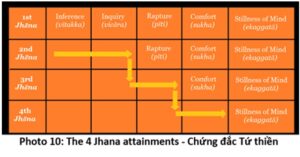
**** **** ****
Proto Buddhism – The Original Teaching of the Buddha
By Venerable Dr. Madawela Punnaji Nayaka Maha Thera
*** ***
Entering Ecstasy
(1) The first ecstasy: with inquiry, inference, serenity, comfort, and stillness of mind.
(2) Then the second ecstasy: with serenity, comfort, and stillness of mind.
(3) Then the third ecstasy: with comfort and stillness of mind.
(4) Then the fourth ecstasy: with stillness and apperception.
Then he began to enter the cognitive ecstasies:
(1) The realm of infinite space
(2) The realm of infinite perception
(3) The realm of nothingness
(4) The realm of neither sensation nor no sensation
(5) The cessation of sensation and feeling.
This last state was the absolute unconsciousness (avijjā), where the consciousness was absent though the body was alive. It was when he woke up from this state that he began to become aware of the mental process by which the “world” that we are aware of, the “self” we are aware of, and the “suffering” we are aware of, came into being. All this came out of the process of perception, conception, cognition, and affection. These psychophysical activities did not arise due to the commandments of a supernatural Creator, but only because of the presence of the necessary conditions.
Trạng thái cuối cùng này là trạng thái vô thức tuyệt đối (avijjā), nơi ý thức vắng mặt mặc dù cơ thể còn sống. Khi thức dậy khỏi trạng thái này, Ngài bắt đầu nhận thức được quá trình tinh thần mà qua đó “thế giới” mà chúng ta nhận thức được, “cái tôi” mà chúng ta nhận thức được và “đau khổ” mà chúng ta nhận thức được, ra đời. Tất cả điều này đến từ quá trình nhận thức, quan niệm, nhận thức và tình cảm. Những hoạt động tâm sinh lý này không phát sinh do lệnh truyền của Đấng Tạo Hóa siêu nhiên, mà chỉ do sự hiện diện của những điều kiện cần thiết.
This experience made him realize that the mind is not an entity separate from the body, but an activity of the body, which when perceived subjectively appears to be mental and when observed objectively appears to be physical. In other words, experience is dichotomized into a subjective and an objective. He also saw that the cognitive process creates the objective “world,” and the affective emotional process creates the subjective “self,” and the resulting suffering.
Kinh nghiệm này khiến Ngài nhận ra rằng tâm trí không phải là một thực thể tách biệt với cơ thể, mà là một hoạt động của cơ thể, khi được nhận thức một cách chủ quan thì có vẻ là tinh thần và khi được quan sát một cách khách quan thì có vẻ là thể chất. Nói cách khác, kinh nghiệm được phân đôi thành chủ quan và khách quan. Ông cũng thấy rằng quá trình nhận thức tạo ra “thế giới” khách quan, và quá trình cảm xúc ái kỷ tạo ra “cái tôi” chủ quan, và kết quả là đau khổ.
*** *** ***

Năm Thiền Chi (Jhānaṇga) và mức độ tiến triển của chúng
Sources:
Tài liệu tham khảo:
- http://lirs.ru/lib/sutra/Long_Discourses_of_the_Buddha(Digha_Nikaya).Walshe.pdf
- https://www.budsas.org/uni/u-kinh-truongbo/truong02.htm
- http://evdhamma.org/index.php/documents/thien-tacgia-va-baiviet/item/1276-tuthien-va-tuegiac-tamminh-song-ngu
- https://thegioiphatgiao.org/viet-anh/phat-phap-can-ban-song-ngu-viet-anh-thien-phuc.html
- Photo 2: http://evdhamma.org/index.php/dharma/dharma-lessons/item/1127-huong-niem-vui-do-su-hai-hoa-song-ngu
- Photo 3: http://evdhamma.org/index.php/dharma/dharma-lessons/item/1127-huong-niem-vui-do-su-hai-hoa-song-ngu
- Photo 4: http://evdhamma.org/index.php/dharma/dharma-lessons/item/1129-huong-an-lac-vuot-ngoai-the-gian-song-ngu
- Photo 5: http://evdhamma.org/index.php/dharma/dharma-lessons/item/161-01-tham-craving-song-ngu
- Photo 6: http://evdhamma.org/index.php/dharma/dharma-lessons/item/161-01-tham-craving-song-ngu
- Photo 7: http://evdhamma.org/index.php/documents/thien-tacgia-va-baiviet/item/1286-huong-niemvui-do-thiendinh-song-ngu
- Photo 8: http://evdhamma.org/index.php/documents/thien-tacgia-va-baiviet/item/1286-huong-niemvui-do-thiendinh-song-ngu
- Photo 9: https://www.slideserve.com/artan/the-jhanas-1358695
- Photo 10: http://evdhamma.org/index.php/documents/thien-tacgia-va-baiviet/item/1286-huong-niemvui-do-thiendinh-song-ngu
- Photo 11: https://www.slideserve.com/artan/the-jhanas-1358695
